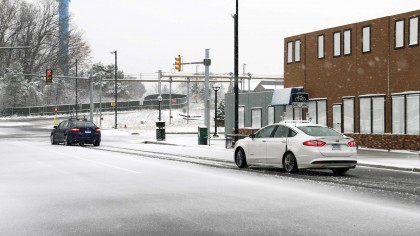Can a self-driving car handle winter? Snooooo problem!
How autonomous cars get around in the snow without you

Ford is currently teaching its fleet of Fusion Hybrid autonomous vehicles to drive in the snow in Michigan. The company announced its testing plans in January, but today reveals how it plans to tackle that frigid, powdery substance that triggers so many accidents.
Driving in the snow is a challenge, even for the most experienced drivers in everyday vehicles. It's not so much the issue of getting the car moving, which is quite easy with a set of winter tires and all-wheel drive, but slowing, stopping, and maintaining visibility.
As humans, we find it hard to see where the lane markers are when there's a couple feet of snow on the ground. Autonomous cars that rely on cameras, sensors and LiDAR technology face the same problems.
Ford's plans for autonomous driving in the snow relies heavily on data. The Ford Fusion Hybrid autonomous cars will create extremely detailed 3D maps using LiDAR technology in good weather to create a baseline map the car can reference later.
The captured data includes everything you see, like signs, buildings, trees, potholes, etc. Ford claims the LiDAR sensors are so precise that it can detect raindrops, snowflakes and your tears of sadness after dropping your phone.

All this information consumes data at the rate of 600GB per hour, which is about the same as filling up five of the largest capacity iPhone 6s' with cat videos, just to collect and process mapping data.
The stored map data is then used as a reference point so the autonomous car can use live LiDAR in winter weather to scan for landmarks and compare it to the map data captured on a clear day, to pinpoint exactly where the car is within 1 centimeter. To put things into perspective, GPS technology is only accurate within 10 yards, which can be the difference between parking in the space or hitting a pole.
Sign up for breaking news, reviews, opinion, top tech deals, and more.
Ford doesn't just rely on LiDAR, however. The Fusion Hybrid autonomous cars have cameras and radar sensors that work with LiDAR to always keep an eye on the road, even if one of the sensors gets a little dirty.
While Ford's autonomous snow driving plans makes a lot of sense in terms of capturing data and locating exactly where the car should be, I wonder how it plans to analyze if the car can drive through a snow-packed road. Just because the car has reference map data and LiDAR information, there's the tire equation (yet).
When it's a brand new car with new tires, everything is fine and dandy, but when the tires are worn, or if the car doesn't have winter tires installed, how will the car determine its capability and when to turn back or skip a road? It's a slippery slope, but it's certainly exciting to see this kind of development already ongoing.